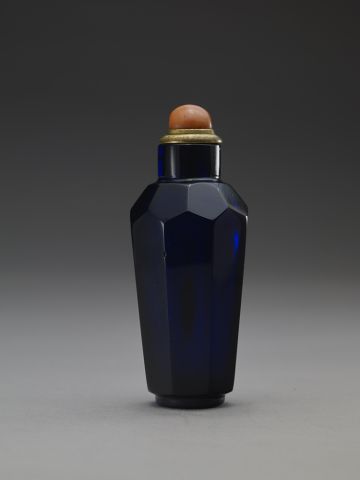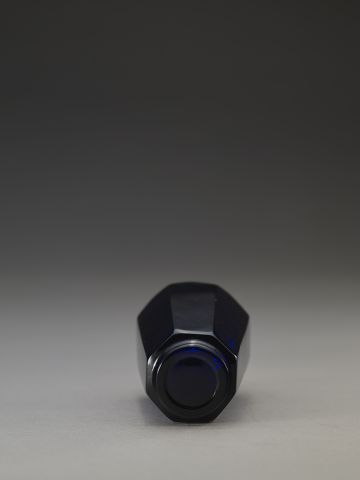

Bottle ID: 724
BLUE, OCTAGONAL, FACETED, UPRIGHT
Date: 1750-1800
Height: 67 mm
Glass, of upright, octagonal tapering form with faceted paneled shoulders, and a cylindrical neck and with a neatly carved circular footrim, the glass of a deep cobalt-blue tone.
Imperial, attributed to the Palace Workshops, Beijing.
Similar Examples:
The Crane Collection, nos. 109 and 444
Moss, Hugh, Victor Graham and Ka Bo Tsang. The Art of the Chinese Snuff Bottle - The J & J Collection, 1993, Vol II, p. 560, no. 333.
JICSBS, Spring 2006, p. 36, fig. 6, The Helen Pritchard Collection (lavender jadeite).
Provenance:
Clare Lawrence Ltd.
The Monimar Collection, purchased 1996
Asian Art Studio
The Collection of Barbara and Marvin Dicker, purchased October 2000
Bonhams San Francisco, June 28, 2016, lot 7042
Despite the popularity in the eighteenth century Imperial Court for Western-influenced forms such as faceting, the more elongated, and hence, the elegant shape of this bottle is rarely seen. Despite its simple lines, which allow the brilliance of the color to shine through, the technique of manufacture is complex. After initially being mold-blown, the faceted panels would have been carved by the lapidaries in a similar fashion to the techniques used by the jade carvers of the time, although using different tools. The final result is a superb bottle that only the Imperial workshops could have produced. The Qianlong Archives of the Imperial Household Department list seven colors of blue, including cobalt-blue which would describe this bottle. The earliest date for blue glass is 1738 when a request was made for a clear blue glass vase to be handed in to the Glasshouse (presumably to be worked upon). The first snuff bottle to be listed was in 1753 when the box workshop was asked to match and fit a box for an embellished translucent blue snuff bottle. Cobalt-blue glass was one of the initial early colors and it is possible that this bottle could have been made as early as the Yongzheng period, although with its form, it is more likley to be a product of the mid-Qianlong period. Dating a glass piece by comparing it to similar marked pieces is a perilous task. In the case of this snuff bottle, the Robert H. Clague Collection in "Chinese Glass of the Qing Dynasty" houses three examples of glass vases of similar forms with vertical panels, each one with a different incised reign mark - Yongzheng (page 79), Qianlong (page 20) and Daoguang (page 48). The first two examples are in blue glass while the third is of clear green. The J & J example listed above has the same formal integrity, intriguingly with its original glass stopper imitating coral, and also being of an "early" glass color. Interestingly, this form occurs in a lavender jadeite bottle in the Helen Pritchard Collection in the Oakland Museum, California. Although its form is remarkably similar, it is more likely to be a slightly later copy of these glass examples; this being evident in the differences such as the splayed foot and the more rounded body.
< Back to full list
 English
English 中文
中文